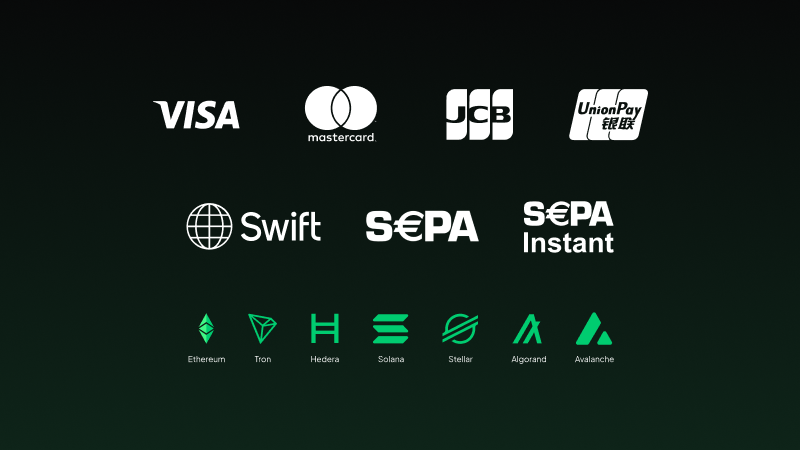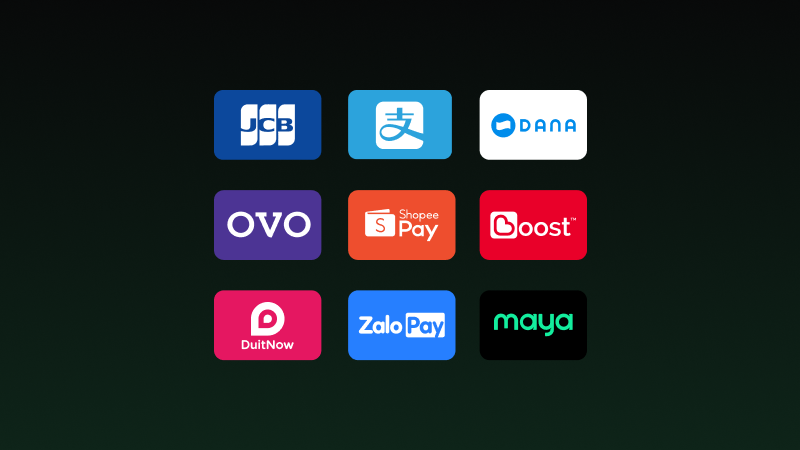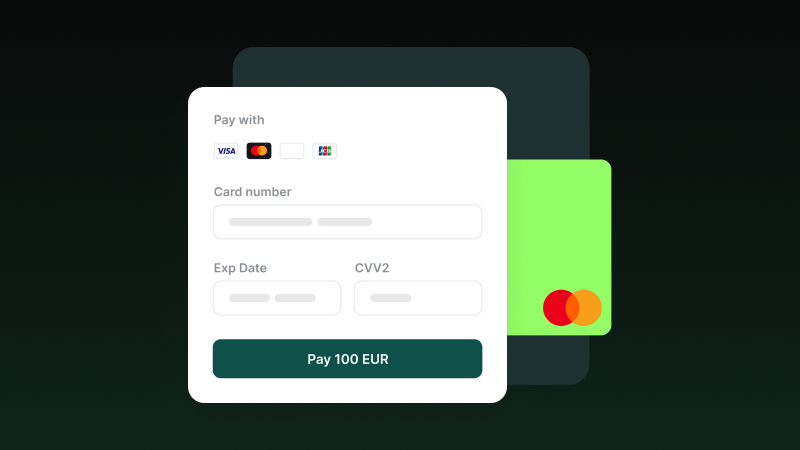But don’t let these situations overwhelm you. Many businesses face hurdles like high transaction fees, frustratingly slow processing, and the ever-present worry of security breaches when choosing a payment method. Fortunately, if you understand payment methods and select the right option for your business, you’ll forget these pain points.
In this article, we’ll guide you through the essentials of payment methods, covering:
- Card processing
- Digital wallets
- Alternative Payment Methods (APMs)
- Blockchain payments and more
Let’s dive in.
What are payment methods?
The way we pay for goods and services online, be it through credit or debit cards, online wallets, or any other mode of payment, we refer to as payment methods. A proper definition of payment methods would be how individuals transfer funds to purchase items or services.
Historically, we first transacted through bartering, where we directly exchanged goods. As our livelihood improved, we migrated to coins and paper currency, followed by checks. Introducing credit and debit cards in the 20th century added convenience to payments.
In the 21st century, digital solutions like online banking, digital wallets, and mobile payments have emerged, offering ease and security during transactions.
Now, these developments, especially in the 21st century, coincided with online business growth and e-commerce. Admittedly, online transactions helped push the evolution of payment methods.
Let’s explore the popular online payment methods.
Card processing
Card processing is a complex yet crucial system that enables the transfer of funds from a customer’s account to a business’s account when a client uses a credit, debit, or charge card. Here’s a closer look at how this process works and its implications for businesses:
How card processing works
- Authorization: When a customer initiates a payment, the merchant sends the card information to the payment processor. This step involves checking the card’s validity and whether the funds or credit limit are sufficient for the purchase.
- Authentication: The payment processor verifies the card’s security features to ensure the transaction isn’t fraudulent.
- Settlement: Once the transaction is confirmed, the funds are taken from the customer’s account and sent to the merchant’s bank account.
Advantages of card processing
- Convenience: Cards are easy to use and widely accepted, making them a preferred payment method for many customers.
- Wider Customer Reach: Accepting cards allows businesses to accept payments from more clients, including international clients who may prefer to pay with their cards.
- Faster Transactions: Card transactions are processed quickly, which can improve cash flow and reduce the time spent on handling cash.
Digital wallets
A digital wallet is like an electronic version of your physical wallet. Instead of carrying cash and cards, you store digital versions of your cards on your phone or a dedicated device. Digital wallets let you make payments, store money, and even carry things like loyalty cards and IDs – all in one place.
Think of it like this: when you shop online, you enter your credit card details each time. Digital wallets store this data securely to simplify and enhance the checkout process. They streamline online shopping by adding convenience during checkout.
Increasing convenience through modernized wallets
Traditional wallets can be cumbersome for modern consumers. The sheer number of cards to choose from may be overwhelming, especially when traveling or trying to choose the right one at checkout. Digital wallets consolidate various payment methods into a single, convenient app. Clients no longer need to rummage through a stack of cards at the checkout, simplifying the process.
Another common pain point is limited currency support. Traditional wallets might only hold one currency or support a single type of currency. Digital wallets eliminate this barrier by allowing users to store and manage multiple currencies and currency types within the app. They simplify the conversion process for clients and businesses by simply holding more currencies.
Finally, the rise of digital currencies has created a need for new payment methods, like digital wallets. They offer secure storage and transaction capabilities for various digital currencies, allowing users to use these alternative payment forms alongside traditional methods.
Advantages of digital wallets
Digital wallets offer several benefits for businesses:
- Faster checkout times: Transactions are faster than traditional payment methods, so your clients won’t have to wait as long to complete transactions.
- Increased security with tokenization: Sensitive information is replaced with unique tokens during transactions, reducing fraud risk and enhancing transaction security.
- Improved customer experience: Digital wallets make shopping easier and faster.
- Incorporating digital currency support: Businesses can accept various forms of digital currency from their clients.
- Interoperability between financial service providers: Digital wallets facilitate smooth interactions between different financial systems, expanding their payment and settlement options.
Alternative Payment Methods
APMs are unconventional transaction methods that often align with local preferences and technologies. These include mobile money, eWallets, cash-based solutions, QR codes, and SMS-powered local payment methods.
Digital native expectations, government initiatives, favorable demographics, and the demand for financial inclusion drive APM adoption in emerging markets. They are prevalent in areas with low banking penetration, providing opportunities to reach underserved populations. APMs have seen rapid growth, especially with the rise of Fintech.
Enabling payments in high-growth markets
Traditional banking infrastructure may not be as developed in many emerging markets, leading to a higher reliance on alternative payment methods. By offering versatile online payment solutions, businesses can tap into a broader customer base that might otherwise be inaccessible.
Alternative payment methods serve local market payment demands, making it easier for businesses to penetrate emerging markets and scale effectively. For instance, the Asia-Pacific (APAC) region is one of the most in-demand markets due to its rapid economic growth and widespread internet adoption. Similarly, areas like the Middle East and North Africa (MENA) present significant business opportunities.
Companies can access specific customer segments by adopting local payment methods, potentially increasing sales. Alternative payment solutions often include options that are familiar and trusted by local consumers, such as online wallets, digital bank applications, and local card payments. Familiarity with the payment method may help build trust with local clients and boost transactions.
Offering a variety of payment methods can also reduce the likelihood of cart abandonment, as customers are more likely to complete a purchase when their preferred payment option is available.
Fun fact:
McKinsey highlights how a push for a cashless economy in Nigeria led to 70% of new merchants accepting digital payments for the first time, thanks to the increasing use of digital wallets.
Blockchain payments
Rooted in the blockchain ecosystem, Web3 payments use blockchain technology and digital currencies, ensuring secure, transparent, and efficient value transfer. Web3 payments are part of decentralized finance (DeFi), which aims to create a more accessible financial system.
Advantages of blockchain payments
So, why are blockchain payments important for businesses?
1. Integration with traditional finance and centralized finance
Blockchain payments allow businesses to bridge traditional finance (TradFi) and centralized finance (CeFi) systems through payment service providers. By integrating these different financial infrastructures, businesses access a more comprehensive and inclusive financial ecosystem for more manageable payments and settlements in their preferred currencies.
2. Connecting DeFi and TradFi
Blockchain payments enables financial businesses to link decentralized finance (DeFi) with traditional finance. Financial services can collaborate through a common blockchain platform to provide complementary services for their respective clients.
3. Access to the Web3 market
Embracing blockchain payments provides businesses access to the expanding Web3 market. Financial service providers can leverage blockchain payments to provide their on or off-ramp solutions, plus other financial solutions to Web3 platforms.
4. Enhanced interoperability
Blockchain payments improve interoperability between various financial services. Businesses can utilize a reliable payment service provider based on a blockchain network to access numerous financial services. With enhanced interoperability, financial businesses access complementary and supplementary financial services from their blockchain peers.
As the blockchain ecosystem evolves, businesses that adopt these payments will be well-positioned to benefit from the ongoing advancements in blockchain technology and digital finance.
Selecting the payment method that works for your business
Choosing the right payment method is essential for businesses to ensure smooth transactions, enhance customer satisfaction, and maintain financial security.
Here’s a framework to help businesses make informed decisions:
- Evaluate your transaction volume. High-volume businesses might benefit from payment methods with lower transaction fees or bulk processing capabilities. Always confirm that your payment gateway presents all the required fees upfront to avoid surprise fees during settlement.
- Understand your customer base. Younger customers may prefer digital wallets and mobile payments, while older demographics might lean toward traditional credit or debit card payments. If possible, integrate a payment service provider that covers multiple payment methods, like APS.
- Prioritize payment methods using updated security features to protect against fraud and data breaches. Look for options that comply with industry standards and regulations.
APS is a reliable, versatile payment gateway that supports numerous payment methods for online business. APS allows your business to receive payments in any currency, digital or fiat, through various methods from supported regions globally. It offers online and on-chain payments, including blockchain transactions, providing additional security and transparency.
FAQs
1. What are online payment methods?
Online payment methods are digital alternatives to cash and checks, enabling secure and instant fund transfers between businesses and consumers over the internet. These methods, including credit cards, digital wallets, and bank transfers, are often facilitated by third-party services known as payment gateways or payment service providers (PSPs).
2. What are the most popular payment methods?
The most popular online payment methods offer a secure and convenient way to pay for goods and services. These include:
- Card payments: Credit and debit cards remain widely used for their ease and global acceptance.
- Digital wallets: Applications that store payment information, allowing businesses to accept payments and receive settlements in their preferred currencies.
- Alternative Payment Methods: Non-traditional payment methods in emerging markets that include mobile wallets such as M-PESA in Kenya or digital banking applications such as Maya in the Philippines.
Sources




